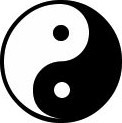(A New Commentary on Wang Zongyue’s Treatise)
The sweet spot in Taijiquan (太極拳), as I understand it, is the fine line between yin (阴) and yang (阳) [traditional characters 陰 and 陽 respectively], i.e., between excess and deficiency, between resisting and collapsing, etc.; or visually, being on the “s-curve” line separating the yin from the yang in the taiji diagram (taijitu 太極圖).

“EXPLAINING TAIJI PRINCIPLES” (太極法說), a book attributed to Yang Banhou (楊班侯) and written circa 1875, contains a section (“TAIJI’S REDUCING MEASUREMENTS”) describing finer and finer levels of precision – from gross movements, through a foot (10 Chinese inches), an inch, a tenth of an inch, and finally to the width of a hair. To me, this describes the increasing level of precision towards the ideal balance between yin and yang.
Taijiquan literature contains many references that can be understood as relating to the concept of the fine line between yin and yang energies. This article offers my understanding of yin and yang through my commentary on “THE TAIJI BOXING TREATISE OF WANG ZONGYUE OF SHANXI” (山右王宗岳太極拳論) as presented in Li Yiyu’s (李亦畬) 1881 manual and translated by Paul Brennan (translations are presented in bold type). [Note: For the full translation, see the following link.]:
https://brennantranslation.wordpress.com/2013/05/25/the-taiji-classics/
 Taiji [“grand polarity”] is born of wuji [“nonpolarity”], and is the mother of yin and yang [the passive and active aspects]. When there is movement, they [passive and active] become distinct from each other. When there is stillness, they return to being indistinguishable.
Taiji [“grand polarity”] is born of wuji [“nonpolarity”], and is the mother of yin and yang [the passive and active aspects]. When there is movement, they [passive and active] become distinct from each other. When there is stillness, they return to being indistinguishable.
The treatise starts by linking the martial art with its philosophical namesake (Taiji). But even without moving, yin and yang are established in one’s body due to Earth’s gravity, the body’s Micro- and Macrocosmic orbits of energy, inherent yin and yang surfaces of the body (e.g., defining our front and back, respectively), etc. Even standing prior to beginning the form, or in zhan zhuang (站樁 standing like a post) stationary postures, we already have up/down, front/back and left/right (i.e., differentiation of yin and yang).
We want to already have six-direction force like a properly inflated ball that expands in all directions. The “movement” that differentiates yin and yang (passive and active) is, therefore, likely referring to interaction with an opponent. With contact, like a ball floating on water that reacts instantly, there should be instant differentiation into yin and yang in a Taijiquan practitioner’s body.
As soon as we are touched, we want to have the sensitivity to be able to move in response, and this movement dictates where yin and yang are in relation to the point(s) of contact (the part that moves away = yin, and the part that moves toward = yang) and the energy from the opponent. However, before contact, we maintain the potential to move in every direction, without the opponent being able to predetermine which way we may go, thus being “indistinguishable” when in “stillness.”
Neither going too far nor not far enough, comply and bend then engage and extend.
This sentence points out that, once yin and yang are distinct, practitioners must pay attention to neither having too much nor too little of either energy. It also presents Taijiquan’s approach to interaction. “Comply and bend” is first yielding in response to the opponent, which then creates the condition where we have the opportunity to attack (“then engage and extend”).
Since yin and yang are determined by the movement in response to the energy at the point(s) of contact, Taijiquan’s strategy becomes one of the opponent committing energy first, and our response creating both defense (yin) and opportunities for offense (yang). Unlike the idea that the best defense is provided by a strong offense, Taijiquan strategy comes more from counterattacking, getting the opponent to commit, and thus reduce their changeability, while we maintain our ability to change and adapt to whatever situation is present; they become yang, while we become yin + yang.
 He is hard while I am soft…
He is hard while I am soft…
Although there is an endless variety of possible scenarios, there is only this single principle [of yielding and sticking] throughout.
This section continues explaining the Taijiquan strategy by contrast with the opponent. It also introduces the concepts of “yielding” and “sticking” which are made possible by the yin + yang energy at the point(s) of contact with the opponent. Regardless of the conditions (e.g., whether fast or slow), the strategy of Taijiquan is to respond to, rather than act in opposition to, or independent of, the energy of the opponent.
Note that “soft” here should probably not be confused with being yin + yin since the first sentence in this section warns against both excess and deficiency when it states “neither going too far nor not far enough.” Thus “soft” is likely referring to the condition of yin + yang as opposed to the more instinctual yang + yang (i.e., fight) or yin + yin (i.e., flight). Yin + yang allows for yielding and sticking rather than fight or flight, since being too yin would prevent sticking, while being too yang would prevent yielding.

Leave a Reply